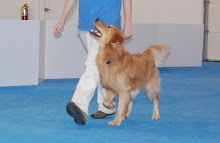
It has been a recent goal to stop saying "game" at the end of every activity name. Seriously. Games need to have an objective, and rules, and I'm not sure what else. But everything can't really be a game.
But somehow this one is still a game.
Objective: Your dog will walk past a distraction in a controlled setting. We systematically train him to make the choice of moving with you and ignoring the dead squirrel.
Have a line you are walking on, 20-25 feet is good. You can use more or less.
Walk back and forth. Feeding for great walking. When your dog is attentive, it's time to add the squirrel.
I do not recommend a real dead squirrel. Pull a silly item out of your garage. Set out something your dog is not supposed to have. The point is, you want to pretend it is a dead squirrel. Do not take risks. Do not move closer to it unless you are sure your dog will stick with you.
The squirrel is placed 15ish feet from your path. You are going to keep walking past it. Feed your dog for good walking. If your dog goes towards it, you will stand and wait for him to come back (...leash is short enough for him not to consume it, remember, dead squirrel! Gross!). Feed. Next rep, move further away.
Do not take risks! Progress slowly! Soon you will go right past it, or over it.
And then you can repeat the activity with new item. And then another. And you can use this on walks as long as the distraction is not a live person or animal. Those things move, making it harder to adjust your path.
Once you've done this lots and lots of times, it won't take a lot for your dog to say "HAH! It's that silly thing again. I won't look! See? I'm not looking at that dead squirrel that is RIGHT there!".
The nice things about this are:
-We are not prompting the dog to return
-The behavior of walking with us is offered
-We are systematically training the dog to walk past distractions
-This is something that can be applied in real life
- It's fairly simple. Most students can self-progress after a minute or two of instruction.
-- Within 2-3 weeks, most dogs in my classes are walking right past food, toys, etc. Not all, but most. In the cases where it does not happen, it's more related to handler skill.
(My photography tactic is to press the buttons a lot of times and hope something happens. Look at this jump!)
- The distraction is the cue for the dog to walk. No "leave it" or name call needed.
But I really like that the students figure out how to progress and what to do and how to modify as needed. It's hard to learn to set criteria! But this is a fairly simple exercise to implement and they tend to be very successful.
It's a staple walking, self control, and criteria setting activity in my classes.



No comments:
Post a Comment